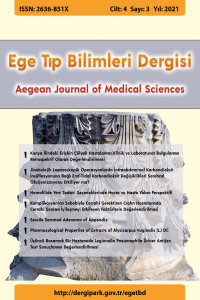Öz
GİRİŞ ve AMAÇ: Günümüzde hemofili hastalığının tedavisinde haftada 2 veya 3 defa intravenöz infüzyonla yapılan profilaktik faktör replasmanı uygulanmaktadır. Son yıllarda dünyada kullanıma giren, ülkemizde de rutin uygulamaya girmesi beklenen farklı tedavi seçenekleri gündemdedir. Bu tedaviler yarı ömrü uzatılmış Faktör VIII ve Faktör IX preperatları (EHL); Concizumab, Emicizumab ve Fitusiran gibi subkutan uygulanan tedaviler ve gen tedavisidir.
Bu çalışmada hemofilikler ve ailelerinin yeni tedavi seçeneklerine bakış açısı, onlardan beklentileri ve çekincelerinin araştırılması amaçlanmıştır.
YÖNTEM ve GEREÇLER: Hasta ve ebeveynlerine yüzyüze görüşme yöntemiyle tarafımızca geliştirilen ‘’Hemofilide Yeni Tedaviler Anketi’’ uygulandı. Elde edilen veriler hasta ve ebeveynler alt gruplarında kesitsel olarak değerlendirildi.
BULGULAR: 32 hasta ve 29 ebeveyn olmak üzere toplam 61 kişiye anket uygulandı. Hemofilikler ve ebeveynlere EHL faktörler hakkındaki tercihleri sorulduğunda, hemofiliklerin 31’i (%96,8), ebeveynlerin 27’si (93,1) evet yanıtını vermiştir (p=0.496). Subkutan moleküller için hemofiliklerin 27’si (%84,3), ebeveynlerin tamamı evet yanıtını vermiştir ve istatistiksel olarak anlamlıdır (p=0.026). Gen tedavisi için hemofiliklerin 27’si (%84.3), ebeveynlerin 26’sı (%89.6) evet yanıtını vermiştir (p=0.542).
Katılımcılardan yeni tedavi seçeneklerinden birini tercih etmeleri istendiğinde her iki grup da gen tedavisini tercih etmiştir.
TARTIŞMA ve SONUÇ: Çalışmada hem hemofilikler, hem de yakınları tarafından en çok tercih edilen tedavi gen tedavisiydi. Subkutan tedaviler ebeveynler, EHL faktörler ise hemofilikler tarafından ikinci sırada tercih edilmekteydi. Tedavi seçeneklerinin tercih edilme nedenleri değerlendirildiğinde, daha az sayıda enjeksiyon olanağı sağlamaları her üç tedavi için de en çok saptanan tercih nedeniydi.
Anahtar Kelimeler
Kaynakça
- 1. Hoyer LW. Hemophilia A. N Engl J Med 1994; 330: 38–47.
- 2. van Dijk K, Fischer K, van der Bom JG, et al. Variability in clinical phenotype of severe haemophilia: the role of the first joint bleed. Haemophilia 2005; 11: 438–443.
- 3. Srivastava A, Brewer AK, Mauser-Bunschoten EP, et al. Guidelines for the management of hemophilia. Haemophilia 2013; 19: e1–47.
- 4. Bolton-Maggs PH, Pasi KJ. Haemophilias A and B. Lancet 2003; 361: 1801–9.
- 5. Plug I, Van Der Bom JG, Peters M, Mauser-Bunschoten EP, De Goede-Bolder A, Heijnen L, et al. Mortality and causes of death in patients with hemophilia, 1992–2001: a prospective cohort study. J Thromb Haemost. 2006;4(3):510–6.
- 6. Plug I, van der Bom JG, Peters M, Mauser-Bunschoten EP, de Goede-Bolder A, Heijnen L, et al. Thirty years of hemophilia treatment in the Netherlands, 1972–2001. Blood. 2004;104(12):3494–500.
- 7. Graf L. Extended Half-Life Factor VIII and Factor IX Preparations. Transfus Med Hemother. 2018 Apr;45(2):86-91.
- 8. Franchini M, Mannucci PM. Non-factor replacement therapy for haemophilia: a current update. Blood Transfus. 2018 Sep;16(5):457-461.
- 9. Meeks SL, Batsuli G. Hemophilia and inhibitors: current treatment options and potential new therapeutic approaches. Hematology Am Soc Hematol Educ Program. 2016;2016:657–62.
- 10. Batty P, Lillicrap D. Advances and challenges for hemophilia gene therapy. Hum Mol Genet. 2019 Oct 1;28(R1):R95-R101.
- 11. von Mackensen S, Kalnins W, Krucker J, Weiss J, Miesbach W, Albisetti M, Pabinger I, Oldenburg J. Haemophilia patients' unmet needs and their expectations of the new extended half-life factor concentrates. Haemophilia. 2017 Jul;23(4):566-574.
- 12. Steen Carlsson K, Andersson E, Berntorp E. Preference-based valuation of treatment attributes in haemophilia A using web survey. Haemophilia. 2017 Nov;23(6):894-903.
- 13. van Balen EC, Wesselo ML, Baker BL, Westerman MJ, Coppens M, Smit C, Driessens MHE, Leebeek FWG, van der Bom JG, Gouw SC. Patient Perspectives on Novel Treatments in Haemophilia: A Qualitative Study. Patient. 2020 Apr;13(2):201-210.
- 14. Balkaransingh P, Young G. Novel therapies and current clinical progress in hemophilia A. Ther Adv Hematol. 2018 Feb;9(2):49-61.
- 15. Lock J, de Bekker-Grob EW, Urhan G, Peters M, Meijer K, Brons P, et al. Facilitating the implementation of pharmacokineticguided dosing of prophylaxis in haemophilia care by discrete choice experiment. Haemophilia. 2016;22(1):e1–10.
- 16. Smit C. Personal reflections of a patient representative in an appraisal committee. Patient. 2015;8(1):5–10.
Ayrıntılar
| Birincil Dil | Türkçe |
|---|---|
| Konular | İç Hastalıkları |
| Bölüm | Orijinal Araştırma |
| Yazarlar | |
| Yayımlanma Tarihi | 9 Aralık 2021 |
| Kabul Tarihi | 8 Ekim 2021 |
| Yayımlandığı Sayı | Yıl 2021 Cilt: 4 Sayı: 3 |



